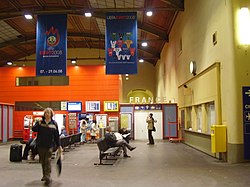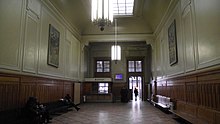Basel SNCF train station
| Basel SNCF | |
|---|---|
 Entrance hall with the customs facilities (2008)
|
|
| Data | |
| Location in the network | Terminus |
| Platform tracks | 5 |
| opening | June 15, 1844 |
| Architectural data | |
| architect | E. Faesch, E. La Roche |
| location | |
| City / municipality | Basel |
| Canton | Basel city |
| Country | Switzerland |
| Coordinates | 611 232 / 266 392 |
| Height ( SO ) | 277 m |
| Railway lines | |
|
|
| List of train stations in Switzerland | |

The station Basel SNCF (also Bâle SNCF , French train station , rare Alsatian Station ) is one of six stations in the city of Basel.
The station is spatially connected to the Basel SBB station, but has its own platform hall with its own tracks and is separated from the SBB station by a customs barrier. The tracks are numbered from 30 to 35, although there is no track 34.
history
On March 6, 1838, the construction of a railway from Strasbourg to Basel began, the Chemin de fer de Strasbourg à Bâle (StB) . A railway commission set up by the Basel government immediately studied a possible continuation of the railway into the city and in May 1840 the government was asked for a corresponding concession . On October 25, 1840, the Strasbourg – Saint-Louis line opened and the Elsässerbahn almost reached the Swiss border .
Fierce debates broke out in the Basel government over the question of whether the train station should be inside or outside the city fortifications. On January 22nd, 1841, the Grand Council of Basel decided to build the train station intra muros (within the walls). Political, religious and urban planning arguments for and against such a facility had been thrown into the discussions, as Basel was still a fortified city at that time and Bahn StB was a French company. Various proposals for the introduction of the railway into the city followed. It was decided to demolish the city wall on Schanzenstrasse and to include the Schällemätteli with a new building , on the site of which the train station should be.
On June 12, 1843, the railway company received the definitive license on the basis of the specifications that laid down all legal, financial and structural provisions for the construction of the railway systems. According to § 3 the railway company u. a. to build the railway line and facility, including a bridge over the new city moat and a gate with an iron portcullis in the city wall. Section 9 also stipulated that the authorities provided the necessary floor space for the station space free of charge. A year later, in 1844, the Elsässerbahn was in a provisional train station in front of the city wall, and in 1845 Basel was the first Swiss city to be connected to the railroad.
Provisional station from 1844/1845
Since the construction of the train station and the new part of the city fortifications was delayed, the StB engineer suggested on March 12, 1844 that a provisional station building be built in front of the city fortifications. This provisional solution may have been the old provisional station building in Mulhouse from 1840. On June 15, 1844, the first train pulled into the station in front of the Basel city walls. On April 1, 1845, eight months before the final station was put into operation, the temporary building fell victim to a fire.
Railway station 1845–1860
In the summer of 1844, construction work began on the station building on the Schällemätteli and in November it was already up and running. Since the construction work on the city fortifications and the railway gate was delayed, the station could only be officially opened and inaugurated on December 11, 1845. The building corresponded to the station building in Mulhouse from 1841 and was designed by Jean-Baptiste Schacre . The elongated reception building was to the side of the track system, had a two-story central building and one-story side wings on the left and right. On the street side it had a continuous canopy and on the track side a wooden railway hall.
Railway gate in the city wall
A specialty was the railway gate in the specially expanded city fortification through which the "French" railway reached the "Swiss" station. Due to the specifications of June 9, 1843, the Elsässerbahn was obliged to build the bridge over the city moat and a secured gate. The Basel architect Melchior Berri designed two projects on February 21, 1844: One gate was a rectangular monumental gate with battlements and a semi-arched passage, the other looked lighter and had a stepped gable, which was also accessible from the city side by stairs. Berri stuck to the second proposal with the stepped gable and construction began. The stones were supplied by Steinmetz Friedrich from Basel, the portcullis from the Stehelin ironworks from Niederschönthal . In December 1845, the gate was made of red sandstone and the train was finally able to enter the city of Basel on December 11th.
According to § 22 of the specifications, the railway company had to the gate by a sentry be guarded, which opened the gate before the arrival of the first train and in the evening after the departure of the last train again closed. Section 26 also gave the Basel authorities the right to interrupt the railway line in the event of war, insurrection or danger of epidemics.
Railway station 1860–1902
In 1858, the Swiss Central Railway decided to relocate its provisional station on Langen Gasse in front of Elisabethenschanze and to build a new station there. At the same time they wanted to connect the French Eastern Railway with this station.
For the purpose of merging, the French line had to be extended from today's Basel St. Johann station to the new location of the station. The line followed the current Kannenfeldstrasse / Steinenring streets and crossed the Birsig cut with a viaduct shortly before the train station .
At the beginning of 1859, construction work began on the station, which, in addition to the passenger station, included the freight station with goods sheds, which was offset from the Gundeldingerquartier , two large warehouses with access from Güterstrasse and two locomotive depots for the Swiss Central Railway and the French Eastern Railway.
On June 4, 1860, the shared station with the Swiss Central Railway was opened. It had a central reception building with a northern front facing the newly created Centralbahnplatz. The station had boarding halls to the right and left , each with two tracks, to the east for the Swiss trains and to the west for the French trains.
The available space, especially in the Swiss part of the station, became increasingly scarce with the increasing traffic and the train traffic of the Alsatian line led to longer and longer barrier closings. In order to eliminate the annoying level crossings along the railway, the Federal Council decided in 1898/99 to relocate the Alsatian line in a low position and in a wide arc around the city at that time, to lower the track system on the station area by 2.7 meters and to create a new community station to build.
In mid-1902, a provisional station was set up for the new Central Station on the already lowered, southern part of the site, and the old station was demolished in 1902/03.
Provisional train station 1902–1907
The provisional station was built on the vacated, sunken area south of the station and put into operation on June 2, 1902. The development also took place from the south, from the Güterstrasse. For this purpose, not only were various streets extended, but also two tram lines . The provisional facility remained in operation until June 24, 1907, the provisional facilities and access roads were then dismantled and the two tram lines in Güterstrasse were tied through. The station underpass into the Gundeldinger district was built around the point of the access road.
Railway station 1907
The new station, designed by E. Faesch and E. La Roche , was put into operation on June 24, 1907, and the Elsässerbahnhof (officially then: Basel Els.-Lothr. Bahn = Basel Elsaß-Lothringer Bahn ) became the distinctive reception building of the Swiss station attached on the western side.
Externally, the clock tower is eye-catching. The station is internally connected to the SBB station by a corridor, but also has its own entrance and is separated from the SBB station by a customs barrier. After passing the border control, the traveler is in the French customs area and arrives through the waiting hall on the three platforms with the five tracks, which are spanned by a platform hall.
The station has been electrified since July 1950. The overhead lines of the tracks carry the French contact line voltage of 25,000 V 50 Hz . Track 30, which is continuous to track 4 of the Swiss train station, can be switched between the French contact line voltage and the Swiss voltage of 15,000 V 16.7 Hz. On the southern side of the station, beyond the parking fields and platforms of the SBB station, there is a double-track line at a lower level, which connects the Basel-Muttenz marshalling yard with the French main line and mainly serves through freight trains.
The station used to have its own counter hall for issuing tickets to France. However, this was given up by the SNCF and switched to self-service at machines. A refreshment facility was given up years ago and there is no kiosk available.
Present and Future
The SNCF station is merging more and more with the SBB station and the SNCF is no longer interested in continuing its own station. It is withdrawing more and more from operations and the SBB are taking on more and more functions such as ticket sales, train handling, etc. From 1997 to 2008, twin-stream shuttle trains of the Basel S-Bahn ran from Frick to Mulhouse through the Swiss station. Since then, regional trains from France have ended up in Basel SNCF again on tracks 30-35, mainly on track 33. The station has been extensively renovated since May 2017 (as the “west wing” of SBB station), which is expected to last until 2021.
Web links
literature
- Werner Stutz: Railway Stations in Switzerland: From the Beginnings to the First World War. Publishing house, Zurich 1976, ISBN 3855720185 .
Individual evidence
- ^ Watercolor approaching train , plan sketch railway gate
- ↑ Eisenbahndirektion Mainz (ed.): Official Journal of the Royal Prussian and Grand Ducal Hessian Railway Directorate in Mainz of October 9, 1915, No. 51. Announcement No. 648, p. 335.
- ↑ News in brief . In: Railway amateur . July 1950, p. 209 .
- ^ Basler Zeitung: Continuous S-Bahn to Alsace is a topic again.
- ↑ The SBB train station becomes a construction site on Telebasel from May 22, 2017

